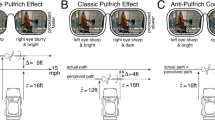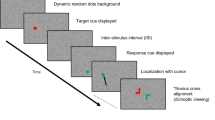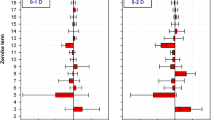Abstract
THE role of eye movements in the promotion, and maintenance of binocular fusion and depth perception is not clear, although experiments1–3 suggest that judgements of depth in a stereoscopic situation may be made with some accuracy in the absence of eye movements. Langlands found reliable perception of depth in normal vision with short exposures of the order of 10−5 sec, but it seems uncertain whether judgements could have been influenced by after-images. It should be possible in principle to solve this problem by “stabilizing” images on the retina after the method of Ditchburn4 and Riggs5, and in 1963 one of us (C. R. E.) tried to study binocular vision with a contact lens stabilizing system in each eye, but with inconclusive results. Partial destabilization because of poor contact lens fit was a probable cause of this lack of success, as Barlow pointed out in a general criticism of this method6. Experiments with an after-image as a “perfectly stabilized image” have been undertaken here7, and, because with suitable methods prolonged clear after-images of patterns can be obtained, we decided to try to study complex stereoscopic patterns in these conditions. (Because the after-image is formed as the result of temporary changes in the state of the retinal cells themselves, it can be considered to be a completely “stabilized” image.)
This is a preview of subscription content, access via your institution
Access options
Subscribe to this journal
Receive 51 print issues and online access
$199.00 per year
only $3.90 per issue
Buy this article
- Purchase on Springer Link
- Instant access to full article PDF
Prices may be subject to local taxes which are calculated during checkout
Similar content being viewed by others
References
Langlands, N. M. S., MRC Special Report Series, 133 (HMSO, 1929).
Ogle, K. N., and Reiher, L., Vision Res., 2, 439 (1962).
Bower, T., Goldsmith, W. M., and Hochberg, J., Percept. Mot. Skills., 19, 510 (1964).
Ditchburn, R. W., and Ginsborg, B. L., Nature, 170, 36 (1952).
Riggs, L. A., Ratcliff, R., Cornsweet, J. C., and Cornsweet, T. N., J. Opt. Soc. Amer., 43, 495(1953).
Barlow, H. B., Quart. J. Exp. Psychol., 15, 36 (1963).
Evans, C. R., Brit. J. Psychol.(in the press).
Julesz, B., Bell System Tech. J., 39, 1125 (1960).
Hall, R. J., and Wilsoncroft, W. E., Psychonomic Sci., 1, 267 (1964).
Author information
Authors and Affiliations
Rights and permissions
About this article
Cite this article
EVANS, C., CLEGG, J. Binocular Depth Perception of “Julesz Patterns” viewed as Perfectly Stabilized Retinal Images. Nature 215, 893–895 (1967). https://doi.org/10.1038/215893b0
Received:
Revised:
Issue Date:
DOI: https://doi.org/10.1038/215893b0
This article is cited by
-
A neurophysiological model for anomalous correspondence based on mechanisms of sensory fusion
Documenta Ophthalmologica (1981)
Comments
By submitting a comment you agree to abide by our Terms and Community Guidelines. If you find something abusive or that does not comply with our terms or guidelines please flag it as inappropriate.



